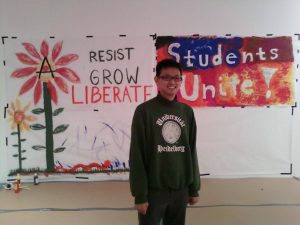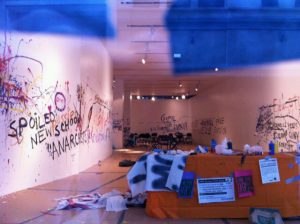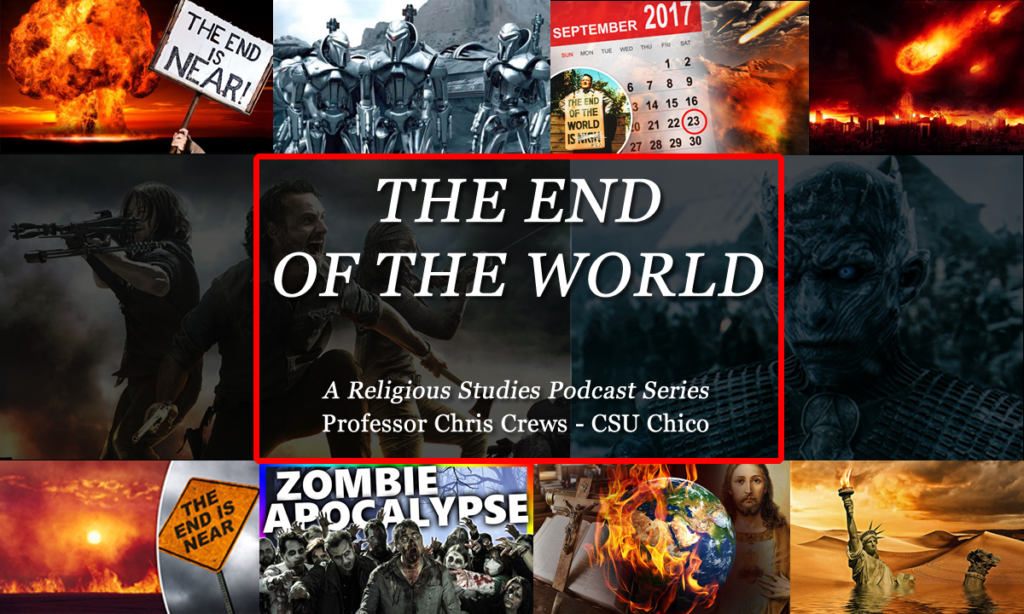Divine Occupation: The Politics of Messianic Insurrections – 1/3
The passion of destruction is a creative joy.
-M. Bakunin
Zoinks! It’s hard to know where to even begin in terms of the past 72 hours of campus politics here at The New School. What began as a cross-university student occupation of a Student Study Center owned by The New School at 90 5th Ave.–which occurred as part of the Nov 17th Student Walkout and Strike–has turned into a political spectacle as a small clique of people attempted to impose a bizarre, messianic insurrectionary authoritarianism upon everyone in the occupation. Key among them was ‘she who cannot be named,’ who had lead the previously botched “Occupy 38” takeover attempt at Artists Space in SoHo. Along the way this small group not only isolated themselves from sympathetic students at The New School, but also from many fellow student activists supporting the occupation. Their final desperate act before evaporating into the ether was to cover Kellen Gallery with various slogans, located at 2. W. 13th St. in the Parsons New School building. This space was being setup by other students who had supported the occupation and wanted to create a second political organizing space, knowing that the 90 5th space would soon be lost, effectively ending the week long occupation. Kellen Gallery was being converted into a temporary space for student organizing as part of the negotiations to leave 90 5th with the university, which took place in a jam-packed and highly tense General Assembly the day before, as well as the following day when the President and Provost came and presented their formal proposal. But in order to understand what went down over the past few days, we need to step back and look at the bigger picture.
Mótus I
First, there is, and has been, a small faction of people–some but not all of whom are New School students–who have attempted to shape the political space in a very particular way, which I had pointed out in an earlier piece called White Privilege and the OWS Student Occupation. That piece, along with a second one exploring what the occupation was doing right, were meant to help our movement reflect critically and honestly on the issues confronting us, which were becoming clearer each passing day, in order not to weaken the movement but instead to widen and deepen support for the occupation. It was, and still is my belief, that this will only happen by honestly addressing these very important concerns and reaching out to a wider audience.
Sadly, but not unsurprisingly, that critique unleashed a maelstrom of hate and knee-jerk reactions denouncing me and my critique. My friend has written some insightful reflection about the responses to all of this in a piece called The All-City Student Occupation is Whose Radical Movement? The gist of the comments were that I had no right to criticize the movement publicly and I should just shut up, as I was a threat to the occupation and was helping to destroy it from within. So much for the valorization of immanent critique…
To understand the subtext of the critique I wrote, two things need to be made clear. First, many people, myself included, who were critical of some of the messaging and tone of the space were frustrated because we wanted to be in full support of our friends and the occupation, but we could not in good faith ignore some of the blatant manifestations of privilege and oppression which were visible and obvious inside the occupation. The fact that we raised these concerns itself became a point of attack against us, and when we continued to raise them anyway, and formed affinity groups to bring them up, these concerns were either dismissed as identity politics or being addressed, apparently as evidenced by the fact that we had working groups trying to raise them. Most of these concerns were not in fact seriously addressed, as was evidenced by the flare ups in the final decisive GA.
Mótus II
Second, many of the concerns raised by student of The New School were not directly political in nature, but were more a response to the perceived hostility of the atmosphere within the occupation and the disruption of study space caused by the occupation of the study center. On this point I have much more mixed feelings. By its very nature an occupation will disrupt the normal routine, as some of the more hardline occupiers repeatedly emphasized, and as I am inclined to agree. But at the same time the space was repeatedly claimed to be a study space where any student could come and study freely, which from all reports, was not really the case. The space was just to busy and noise to really function as a study space for anyone needing any semblance of quiet. But the deeper problem was that students repeatedly raised the concern about studying to the occupation, and in particular, within the General Assembly. Every time this concern was raised, students were either dismissed, laughed at or attacked for bringing these concerns to the GA. Ultimately, this proved to be one of the reasons that the occupation collapsed from within, as a large number of angry students finally voted to end the occupation–roughly 90 in favor and 25 against–thus creating an irreconcilable rift within the occupation.
But the much larger tension which the occupation manifested and made clear for many of us is the danger of an empty and reactionary form of insurrectionary politics which has no problem attacking anyone who disagrees with them, and speaks in the language of divine violence and retribution through terror. There politics is reminiscent of the Jacobin Reign of Terror during the French revolution, the Great Purge of 1930’s Stalinist Russia, or the Communist purges of anarchist in 1937 Barcelona, except they don’t have the political will to actually purge anyone. It’s also an extremely paranoid political tendency, as witnessed by the near-absolute ban imposed on all media, both mainstream as well as friendly movement media–which was very odd given the repeated rhetoric about the supposed openness of the space. But ultimately, this was a ruse to hide their real politics behind a veneer of radical openness which was in fact very tightly controlled and militantly policed. But don’t take my word for it–this messages was quite explicit and clear in the 90 5th space.
[* Note: With two exceptions (the All-City GA and the People’s University), the students occupying the 90 5th space had imposed a total ban on press in the space. However I have come across numerous instances of images taken from within the occupation, including this video clip from the contentious GA. It is worth noting that images from within the occupation appeared on blogs associated with the more hardline faction who had imposed the media ban in the first place (1, 2)…]













